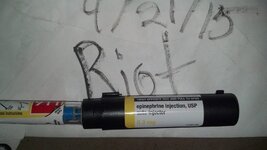- Messages
- 1,208
- Reactions
- 1,380
An adult epi pen delivers 0.3mg - this one has 40 times that amount per MD. It's probably an indication for how much more effective the uptake is when delivered IM.Apparently, there is recently another OTC product, containing epinephrine, that is now safe for the ozone layer.
According to a press release from Nephron, its product, Asthmanefrin, was available in retail outlets beginning in late August. The inhaler contains 11.25 mg racepinephrine per 0.5 ml puff as an active ingredient. The solution is not made with CFCs or preservatives. It is available as a 10-vial starter kid that includes an atomizer and as a 30-vial refill kit. - See more at: http://www.pharmacytimes.com/news/New-OTC-Inhaler-on-Store-Shelves#sthash.PsQrHPUL.dpuf
WAYNO.












